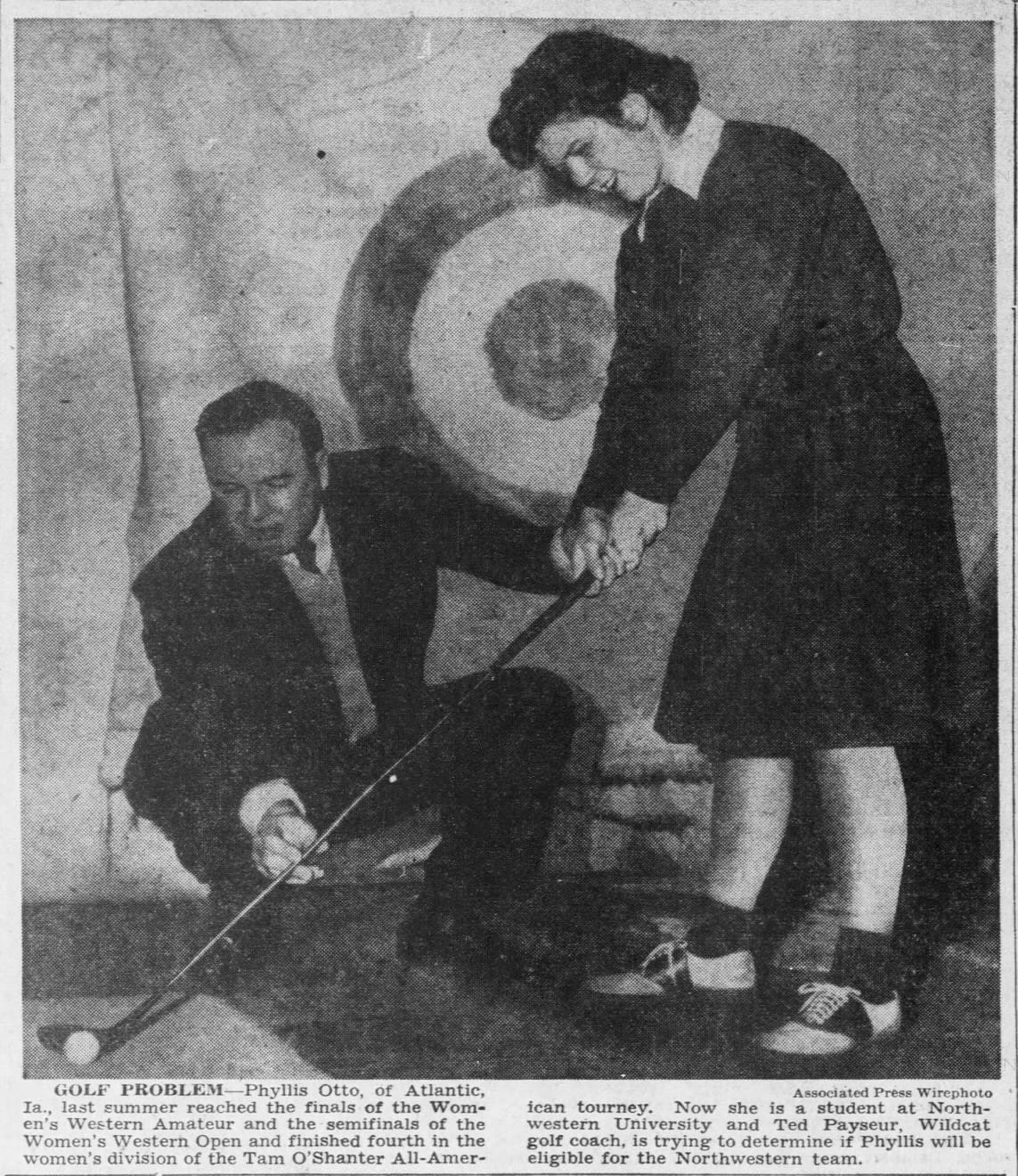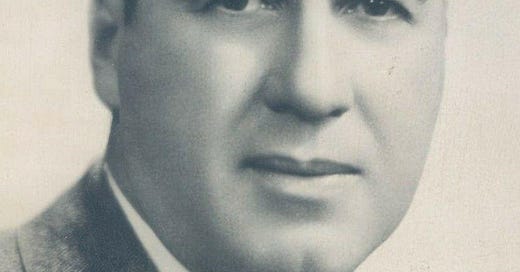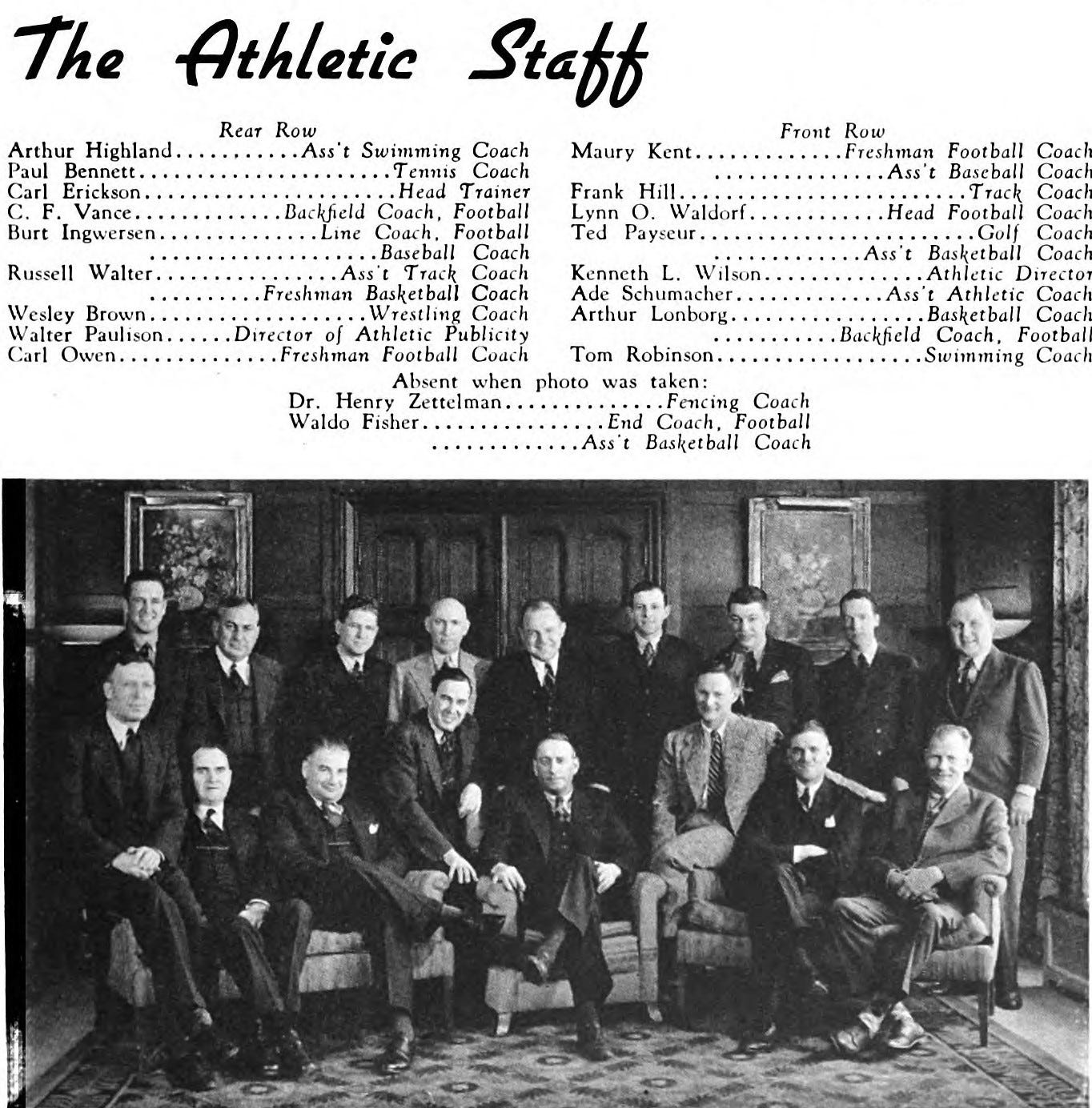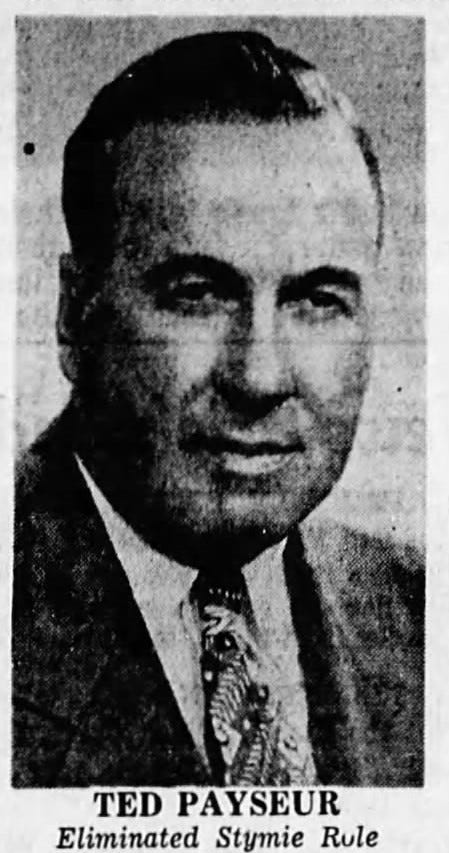Historic Profile: Ted Payseur (Part II)
Bulldog, Wildcat, and One of the College Golf G.O.A.T.s
TED PAYSEUR: BULLDOG, WILDCAT, AND ONE OF THE COLLEGE GOLF G.O.A.T.s
It’s hard to be more connected to college golf history than Theodore “Ted” Payseur. From player to coach to athletic director and prominent NCAA committee chairman, Payseur touched all aspects of collegiate golf on the men’s side, and even has direct connections to the rise of women’s intercollegiate golf following WWII. Over the span of 40+ years from the 1920s-60s, this “cornfed golfer” from Iowa was a central figure as college golf expanded from a primarily East Coast competition to a truly national sport.
THIS IS PART 2 OF 2
COACH AND ATHLETIC DIRECTOR

High School Coach and Early Northwestern Years
After Drake, Payseur became the basketball and track coach at Dubuque (Iowa) High School. He stayed in that position until 1926 when he became, among other things, the head of the intramural department at Northwestern University. By 1929, Payseur was listed as the assistant basketball coach and the golf professional at Dubuque Country Club, positions he held for the next three-ish years.
Northwestern University Golf Coach [1932-1945]
The start of the Fall 1932 term brought with it an inevitable and eventually historic change as Ted Payseur was named the new golf coach at Northwestern (in addition to his basketball coaching duties), taking over from Leon Kranz who was the Director of the Department of Physical Education and who had become the University’s first golf coach in 1923.
Unfortunately there’s no way around glossing over quite a bit of cool history here. Michigan had just risen to national prominence - going on to be the first “Western” team national champs in 1934 and then again in 1935 - but Payseur quickly brought Northwestern up to being the second best Big Ten team. The 1937 season was the debut of Sid Richardson, sophomore superstar who took individual honors as he lead Northwestern to only its second Big Ten championship (1925) and in the process snapping Michigan’s five-year winning streak. Minnesota edged out Northwestern in the 1938 Big Ten championship by a mere five strokes, but Sid Richardson repeated as the individual champion. That year at the national championship, Northwestern finished T2 (along with Oklahoma) right behind Stanford, and Richardson was named the next IGA President for the 1938-39 season, an important position on the student-ran body that worked with the USGA in running the yearly national championship tournament.
“As I pass through the years, the picture never fades of Ted hanging off to the side by some tree and occasionally coming over to offer a word of advice. We were the only team ever to defeat the great Louisiana State team of Fred Haas and Paul Leslie, and it was only accomplished by Payseur’s strategy. He never tried to change your game except mentally and he always had you pegged right. A greater guy in all ways never lived.”
-1938 team captain Bill Kostelecky
The 1939 season brought with it a plethora of excitement and interesting changes centered around the NCAA taking over responsibilities for the national golf championship from the USGA. A new NCAA Golf Committee was created to oversee this task, and Northwestern held two of the seven positions on Chairman Chick Evans’ committee: Payseur (member) and Richardson (IGA President). We’ll cover more on Payseur’s contributions as an NCAA Golf Committee member further down, but you can imagine the energy that no doubt permeated that Spring season as Northwestern once again took home the team and individual (Chase Fannon over teammate Richardson) Big Ten titles and prepared for the first NCAA golf championship which Payseur helped bring to a Des Moines, Iowa course (Wakonda) for the first time in the tournament’s history. Northwestern once again finished T2 (with Princeton) just two strokes behind Stanford as Richardson became the first Northwestern player to earn championship medalist honors. Unfortunately none of the Wildcats made it out of the first round of individual match play.
Although there was an expected dip after Sid Richardson and Chase Fannon graduated, Payseur’s teams continued to excel at both the Big Ten and NCAA championships. The addition of Dick Haskell and Manuel De la Torre proved huge for the Wildcats. In the 1942 NCAA championship, the team finished 3rd (Stanford and LSU shared title), Haskell became the second Wildcat medalist1, and De la Torre finished as the runner-up in individual match play.
“Much of our success at Chain O’Lakes in ‘42 was due to Coach Ted Payseur. I still remember how Ted sat down with the whole team after several practice rounds and went over each hole of the course. Our success was no accident, as Ted’s strategy was well planned.”
-1942 team captain Dick Haskell
The war years were not kind to college golf as many players, coaches, and sometimes entire programs took a break to fulfill their patriotic duty. Northwestern hosted the 1943 NCAA championship at Olympia Fields CC and finished 5th in a severely depleted field. After not participating in the 1944 championship, Northwestern returned in 1945 as Payseur led a team of freshmen to another runner-up finish in both the Big Ten and NCAA championship (T2 with Michigan) behind the Ohio State team winning a title on their home course.
Northwestern course and Women’s Intercollegiate connection [1945]
Two very interesting things happened in 1945 involving Payseur and one of the top amateur players in the country, Phyllis Otto.

After purchasing the property containing Wilmette Country Club in 1944, Northwestern renovated the area and opened the Northwestern University Golf Course in the Spring of 1945. Festivities including a debut match against Illinois Tech originally scheduled for early April was postponed by a month out of respect for the late President Roosevelt. The May 11th dedication ceremony officially opened the course with a ceremonial exhibition match with the mixed foursome of Chick Evans, Lillian Townsend (“a leading midwestern woman golfer”), Don Heppes (captain of Northwestern’s first Big Ten championship team in 1925), and Phyllis Otto.
Otto, a Junior at Northwestern, had recently reached the Women’s Western Amateur Finals and was one of the top amateurs in the women’s game. She was so good, in fact, that there are several newspaper accounts in 1944-45 that indicate Payseur was considering adding her to the University golf team, likely signaling that he was working behind the scenes to clear whatever hurdles were needed to gain acceptance for a female player on men’s team, considering there was no other collegiate option for her.
This wasn’t the first time that Northwestern had come close to adding a female player to the golf team. In 1928, Wisconsin sophomore Dorothy Page made a concerted effort to join her university golf team, but was ultimately “discouraged” by the athletic board despite there being no clear rule in the Big Ten conference against her joining the team. Northwestern AD “Tug” Wilson was one of those who publicly stated support for the idea of women collegiate golfers as one of his students, Florence Beebe - Illinois women’s state golf champion - was herself interested in possibly joining the university golf team.
It wasn’t until 1941 that a women’s intercollegiate championship existed, finally giving women like Page and Otto a chance to compete for a collegiate title. Unfortunately, just as soon as it had begun, the outbreak of war for the United States resulted in the second tournament being cancelled and it had yet to be held again as Payseur tried adding Otto to the only team playing competitive golf at the university. Although she ultimately never played on the men’s team in 1945, Phyllis Otto would represent Northwestern well in 1946 when the women’s intercollegiate championship was finally restarted. She and Mary Ann Findlay teamed up to finish 2nd in the stroke play portion, and Otto would go on to beat her future sister-in-law, Dorothy Germain, for the individual title in match play. Payseur had to have been immensely proud to see Otto achieve the type of collegiate golf success that hadn’t been open to her even a year prior.
Northwestern University Athletic Director [1945-56] & Assistant to the University President [1957-69]
In the Spring of 1945, Ted Payseur was elevated to the position of athletic director after the previous AD, Kenneth “Tug” Wilson, was named commissioner of the Big Ten. Payseur quickly found that he would be unable to continue coaching on top of this new responsibilities. Fortunately, three military veterans would return to help. Sid Richardson returned from the Pacific to take over as the new head golf coach, a position he would hold for the next 30 years. Coach Richardson’s first team in 1946 included former letterman returning from duty: (team captain) Manuel De la Torre and Pete Panko. Under Payseur’s guidance, Richardson led the men Wildcat golfers to a number of great seasons including another Big Ten team title in 1948 and a number of top 10 and top 20 finishes at the NCAA championship. Likewise, he got to see the beginnings of the women’s university team that would again gain national success when Mariam Bailey earned medalist honors and the individual title in the 1957 championship.
Other random facts
Once turned away infamous gangster Al Capone who had offered Payseur a new car for tickets to a sold-out football game against Notre Dame. According to Payseur, he didn’t know who the “flashily dressed guy [who came in] waving a cigar” was and steadfastly responded “I told him it didn’t make any difference how I’d like that car because there weren’t any tickets left.” Payseur went on to say “Show you how dumb I was, I didn’t know it was Capone. I found out later. He went to the Orrington Hotel (in downtown Evanston) and told people there he’d finally met a man who couldn’t be bought.”
NCAA
NCAA Golf Committee Chairman [1939-58]
As mentioned above, Ted Payseur was one of the original 8 NCAA Golf Committee members 1939 when the USGA and IGA agreed with the NCAA to transfer over majority control of the annual championship to the collegiate athletics organization. He remained a committee member even after turning over coaching responsibilities at Northwester, and served as the Committee Chairman from 1948-58.
Payseur was said to have been one of the lead figures in deciding the location for the NCAA golf championships throughout his tenure on the NCAA committee, and was instrumental in bringing it to two Iowa courses: Wakonda Club (Des Moines, 1939) and Iowa State’s home course (Ames, 1949). As we mentioned in another post, an interesting chain of events brought both the men’s NCAA golf championship and the first ever women’s intercollegiate championship to Ohio State’s brand new course in 1941. This set a precedent of hosting NCAA golf championships on university courses around the country with a few exceptions, including Payseur getting his Northwestern team as the host for the 1943 NCAA championship held at nearby Olympia Fields CC since the University’s own home course wasn’t completed until 1945.
In 1959, Payseur turned over the NCAA Golf Committee Chairman role to Ohio State golf coach Robert Kepler. It’s impossible to fully calculate the impact Payseur had while in that role, but reports like the one below suggests it went well beyond just college golf.
The man truly did it all, and although he was never tagged with the same “Mr. College Golf” moniker that others received, it’s easy to argue that Ted Payseur is one of college golf’s greatest representatives and caretaker.
There’s a rather interesting story behind Haskell “winning” the medalist honors in 1942. He technically finished 2nd, but due to a rule that reigning winners got automatic exemption into match play and some sportsmanship by reigning champ (and medalist) Earl Stewart [LSU], Haskell goes down in the record books as the official medalist. Also interesting was the fact that Chick Evans, who briefly attended Northwestern in 1911, awarded the medalist honors to a player attending Northwestern on one of his scholarships in both his first (1939 - Sid Richardson) and last (1942 - Dick Haskell) tournaments as NCAA Golf Chairman.









I am so thankful that you were able to take the time to do such a thorough research of Ted Payseur’s golf and athletic career. I sat beside Ted, my grandfather, many times to hear some but certainly not all of these stories. Grandpa Payseur and my Dad inspired me to play the great game of golf. I was fortunate to be a team member and play in the 1975 NCAA Division 3 Championships for Thiel College. You have brought back to life some wonderful memories for me.
Sincerely, Bob Hagmann
Thank you for writing these historical details! Ted Payseur was my grandfather and it’s so valuable for me to have more of his professional story documented. I knew him as Grandpa…